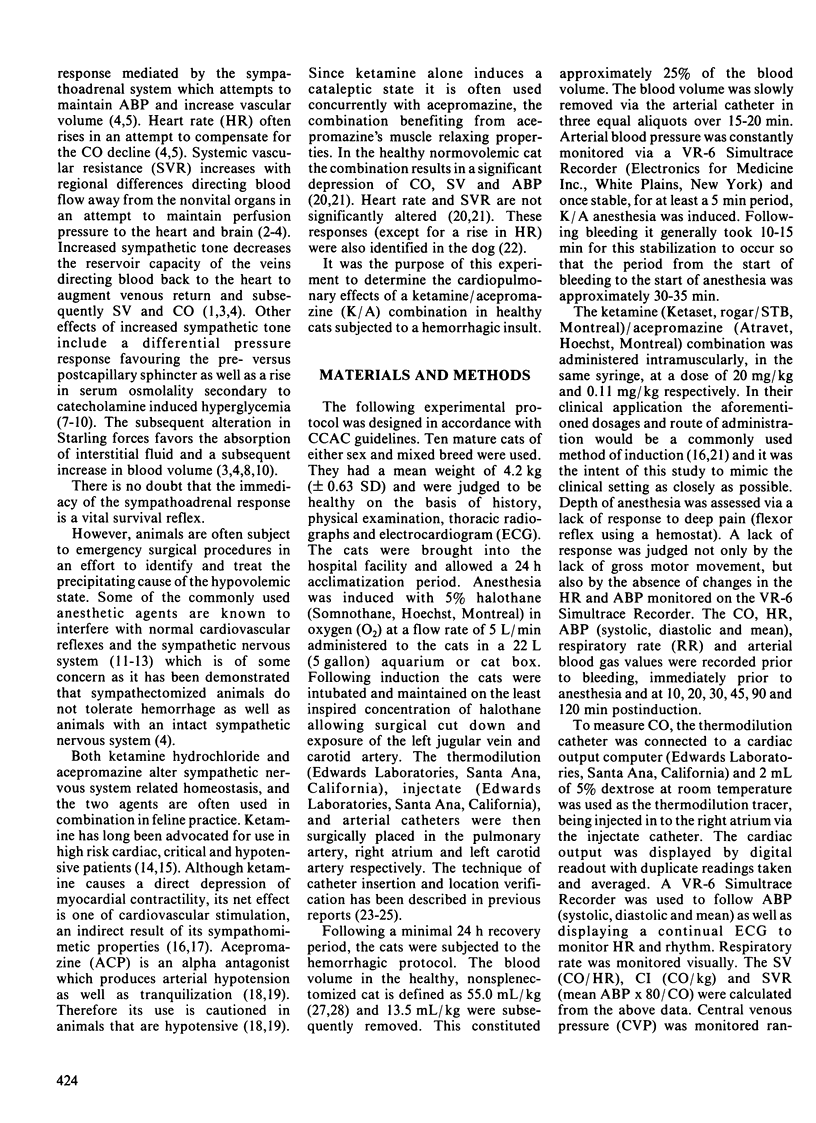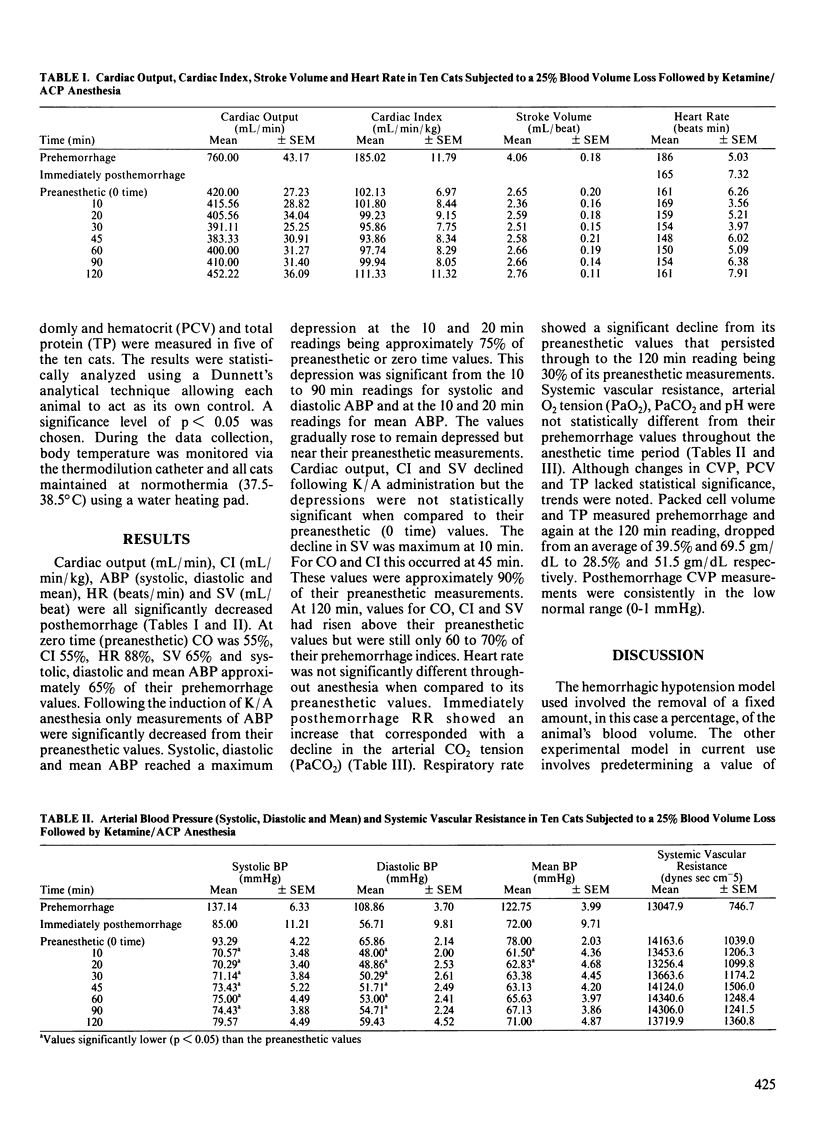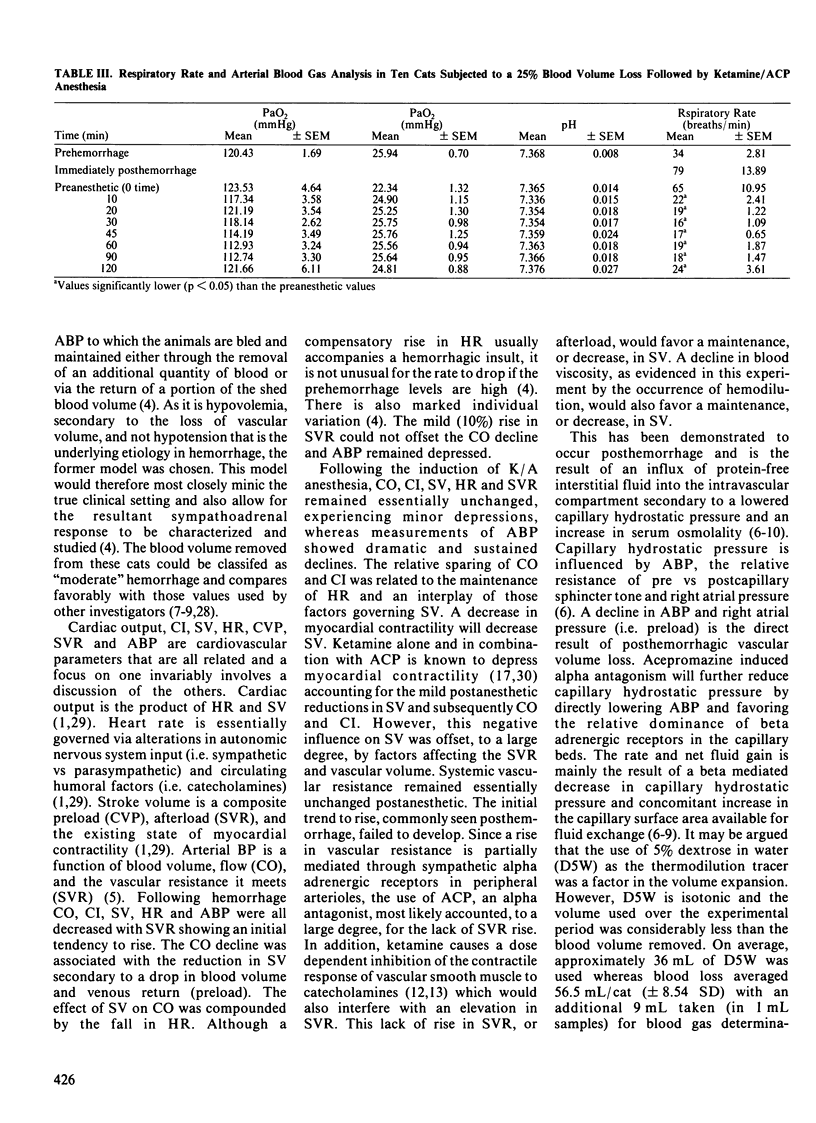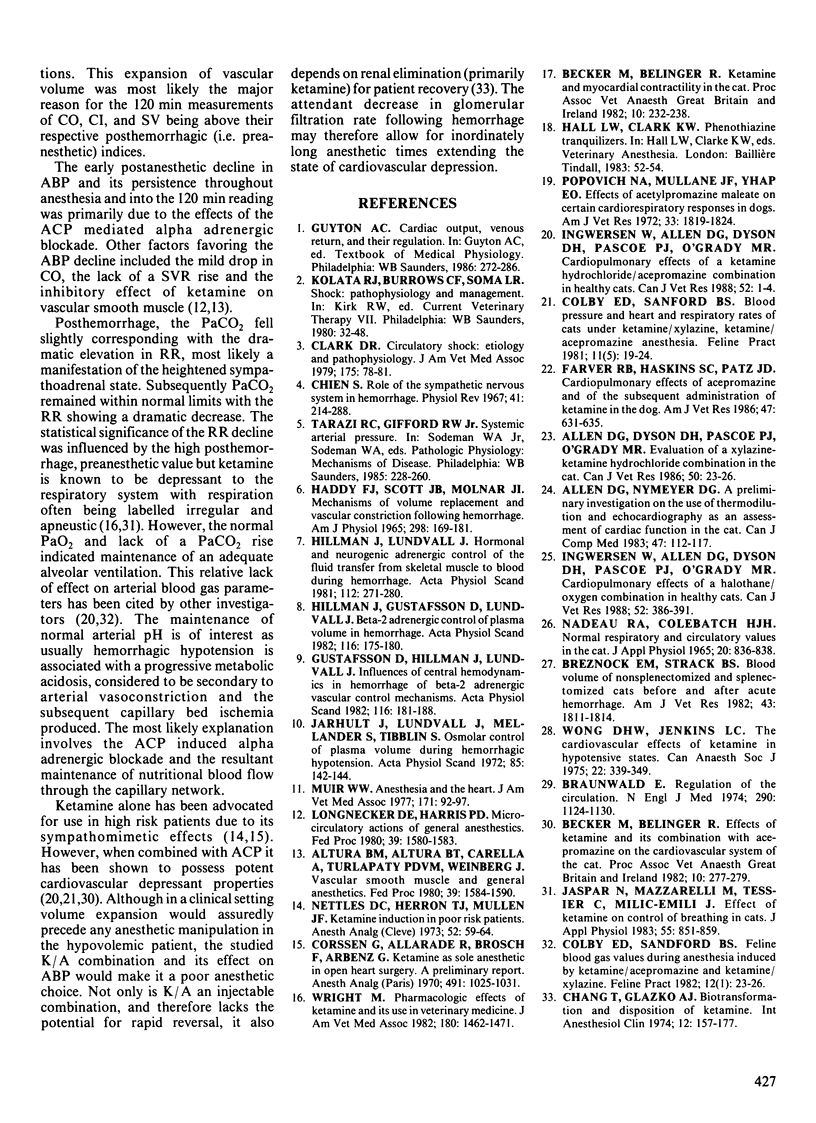Abstract
The cardiopulmonary effects of a ketamine/ acepromazine combination was studied in ten cats subjected to a 25% whole blood volume loss. Test parameters included cardiac output, measured via thermodilution, heart rate, respiratory rate, arterial blood pressure (systolic, diastolic and mean) and blood gas analysis. Values for cardiac index, stroke volume and systemic vascular resistance were calculated from these data. Posthemorrhage, cardiac output, cardiac index, stroke volume, heart rate and measurements of arterial blood pressure were significantly decreased (p less than 0.05). Following the induction of ketamine/ acepromazine anesthesia, cardiac output, cardiac index, stroke volume and heart rate showed mild but statistically insignificant declines and were above their respective posthemorrhage values 120 min into ketamine/ acepromazine anesthesia. Measurements of arterial blood pressure showed further declines from their respective posthemorrhage values that were statistically significant (p less than 0.05). Following hemorrhage, respiratory rate increased significantly (p less than 0.05), associated with a fall in arterial CO2 tension. During ketamine/ acepromazine anesthesia, respiratory rate showed a dramatic and significant decline (p less than 0.05) with arterial CO2 tension rising to prehemorrhage values. Systemic vascular resistance, arterial O2 tension and pH remained essentially unchanged throughout the experimental period.
Full text
PDF




Selected References
These references are in PubMed. This may not be the complete list of references from this article.
- Allen D. G., Dyson D. H., Pascoe P. J., O'Grady M. R. Evaluation of a xylazine-ketamine hydrochloride combination in the cat. Can J Vet Res. 1986 Jan;50(1):23–26. [PMC free article] [PubMed] [Google Scholar]
- Allen D. G., Nymeyer D. A preliminary investigation on the use of thermodilution and echocardiography as an assessment of cardiac function in the cat. Can J Comp Med. 1983 Apr;47(2):112–117. [PMC free article] [PubMed] [Google Scholar]
- Altura B. M., Altura B. T., Carella A., Turlapaty P. D., Weinberg J. Vascular smooth muscle and general anesthetics. Fed Proc. 1980 Apr;39(5):1584–1591. [PubMed] [Google Scholar]
- Braunwald E. Regulation of the circulation. I. N Engl J Med. 1974 May 16;290(20):1124–1129. doi: 10.1056/NEJM197405162902008. [DOI] [PubMed] [Google Scholar]
- Breznock E. M., Strack D. Blood volume of nonsplenectomized and splenectomized cats before and after acute hemorrhage. Am J Vet Res. 1982 Oct;43(10):1811–1814. [PubMed] [Google Scholar]
- Chang T., Glazko A. J. Biotransformation and disposition of ketamine. Int Anesthesiol Clin. 1974 Summer;12(2):157–177. doi: 10.1097/00004311-197412020-00018. [DOI] [PubMed] [Google Scholar]
- Chien S. Role of the sympathetic nervous system in hemorrhage. Physiol Rev. 1967 Apr;47(2):214–288. doi: 10.1152/physrev.1967.47.2.214. [DOI] [PubMed] [Google Scholar]
- Clark D. R. Circulatory shock: etiology and pathophysiology. J Am Vet Med Assoc. 1979 Jul 1;175(1):78–81. [PubMed] [Google Scholar]
- Corssen G., Allarde R., Brosch F., Arbenz G. Ketamine as the sole anesthetic in open-heart surgery. A preliminary report. Anesth Analg. 1970 Nov-Dec;49(6):1025–1031. [PubMed] [Google Scholar]
- Farver T. B., Haskins S. C., Patz J. D. Cardiopulmonary effects of acepromazine and of the subsequent administration of ketamine in the dog. Am J Vet Res. 1986 Mar;47(3):631–635. [PubMed] [Google Scholar]
- Gustafsson D., Hillman J., Lundvall J. Influences on central hemodynamics in hemorrhage of beta 2-adrenergic vascular control mechanisms. Acta Physiol Scand. 1982 Oct;116(2):181–188. doi: 10.1111/j.1748-1716.1982.tb07128.x. [DOI] [PubMed] [Google Scholar]
- HADDY F. J., SCOTT J. B., MOLNAR J. I. MECHANISM OF VOLUME REPLACEMENT AND VASCULAR CONSTRICTION FOLLOWING HEMORRHAGE. Am J Physiol. 1965 Jan;208:169–181. doi: 10.1152/ajplegacy.1965.208.1.169. [DOI] [PubMed] [Google Scholar]
- Hillman J., Gustafsson D., Lundvall J. beta 2-Adrenergic control of plasma volume in hemorrhage. Acta Physiol Scand. 1982 Oct;116(2):175–180. doi: 10.1111/j.1748-1716.1982.tb07127.x. [DOI] [PubMed] [Google Scholar]
- Hillman J., Lundvall J. Hormonal and neurogenic adrenergic control of the fluid transfer from skeletal muscle to blood during hemorrhage. Acta Physiol Scand. 1981 Jul;112(3):271–280. doi: 10.1111/j.1748-1716.1981.tb06816.x. [DOI] [PubMed] [Google Scholar]
- Ingwersen W., Allen D. G., Dyson D. H., Pascoe P. J., O'Grady M. R. Cardiopulmonary effects of a halothane/oxygen combination in healthy cats. Can J Vet Res. 1988 Jul;52(3):386–391. [PMC free article] [PubMed] [Google Scholar]
- Ingwersen W., Allen D. G., Dyson D. H., Pascoe P. J., O'Grady M. R. Cardiopulmonary effects of a ketamine hydrochloride/acepromazine combination in healthy cats. Can J Vet Res. 1988 Jan;52(1):1–4. [PMC free article] [PubMed] [Google Scholar]
- Jaspar N., Mazzarelli M., Tessier C., Milic-Emili J. Effect of ketamine on control of breathing in cats. J Appl Physiol Respir Environ Exerc Physiol. 1983 Sep;55(3):851–859. doi: 10.1152/jappl.1983.55.3.851. [DOI] [PubMed] [Google Scholar]
- Järhult J., Lundvall J., Mellander S., Tibblin S. Osmolar control of plasma volume during hemorrhagic hypotension. Acta Physiol Scand. 1972 May;85(1):142–144. doi: 10.1111/j.1748-1716.1972.tb05245.x. [DOI] [PubMed] [Google Scholar]
- Longnecker D. E., Harris P. D. Microcirculatory actions of general anesthetics. Fed Proc. 1980 Apr;39(5):1580–1583. [PubMed] [Google Scholar]
- Muir W. W. Anesthesia and the heart. J Am Vet Med Assoc. 1977 Jul 1;171(1):92–98. [PubMed] [Google Scholar]
- Nadeau R. A., Colebatch H. J. Normal respiratory and circulatory values in the cat. J Appl Physiol. 1965 Sep;20(5):836–838. doi: 10.1152/jappl.1965.20.5.836. [DOI] [PubMed] [Google Scholar]
- Nettles D. C., Herrin T. J., Mullen J. G. Ketamine induction in poor-risk patients. Anesth Analg. 1973 Jan-Feb;52(1):59–64. [PubMed] [Google Scholar]
- Popovic N. A., Mullane J. F., Yhap E. O. Effects of acetylpromazine maleate on certain cardiorespiratory responses in dogs. Am J Vet Res. 1972 Sep;33(9):1819–1824. [PubMed] [Google Scholar]
- Wong D. H., Jenkins L. C. The cardiovascular effects of ketamine in hypotensive states. Can Anaesth Soc J. 1975 May;22(3):339–348. doi: 10.1007/BF03004843. [DOI] [PubMed] [Google Scholar]
- Wright M. Pharmacologic effects of ketamine and its use in veterinary medicine. J Am Vet Med Assoc. 1982 Jun 15;180(12):1462–1471. [PubMed] [Google Scholar]


